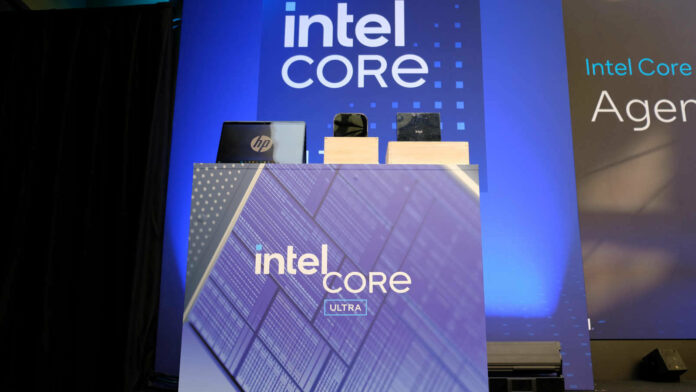Say hello to Intel’s Core Ultra 200V series CPUs, powered by the company’s Lunar Lake architecture. These processors are a far cry from their Meteor Lake predecessors, boasting seriously large generational efficiency and performance gains. There’s lots to talk about when it comes to these chips, including new core and graphics designs and comparisons to competitors. First impressions, though, are impressive and welcomingly positive.
Core Ultra 200V series processors aim to be the best CPUs for thin and light devices, which includes the likes of notebooks and handheld gaming PCs. Intel is the last manufacturer to play its hand this year, following after AMD’s Ryzen AI 300 series and Qualcomm’s Snapdragon X Elite chips. This doesn’t mean the company’s lagging behind, far from it.
If Team Blue’s claims hold true, Lunar Lake could mark the beginning of a path to cultural and financial recovery. We’ll have a clearer idea once devices with Core Ultra 200V processors hit the market September 24, with pre-orders starting today. In the meantime, here’s what Intel had to say about its latest batch of CPUs.
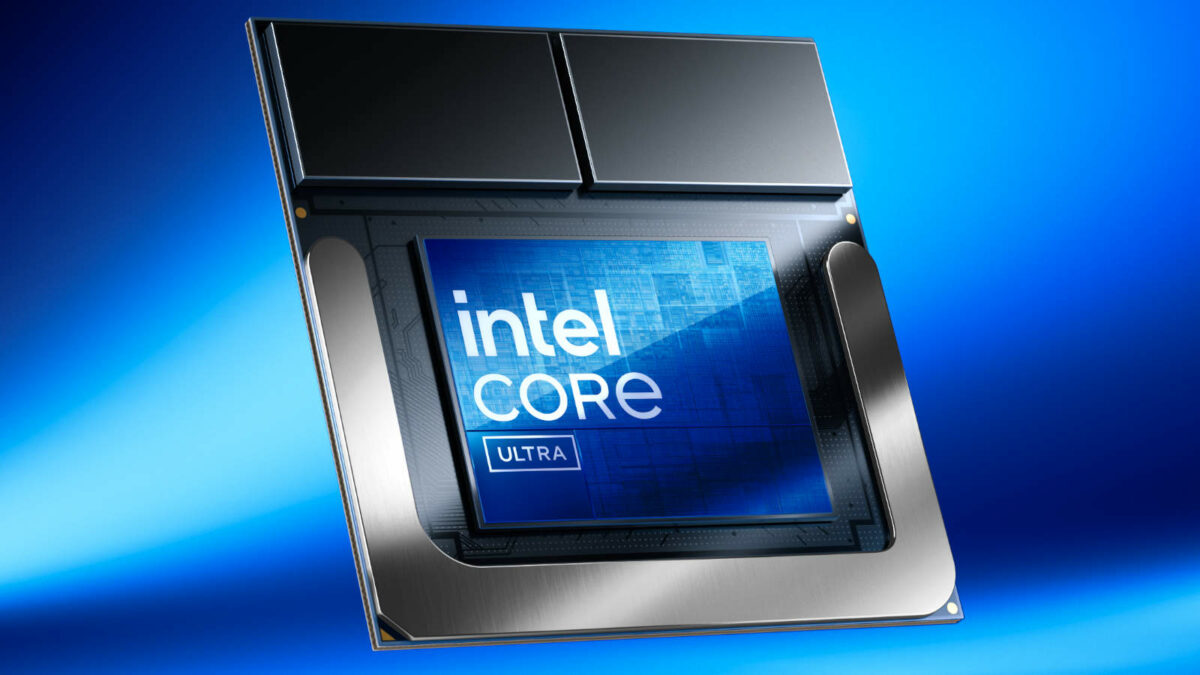
Intel Core Ultra 200V series SKUs
| CPU | Base Power | Cores (P/LP E) | Threads | Turbo (P/E) (GHz) | RAM | GPU | Max. Freq. (GHz) | NPU (TOPS) |
|---|---|---|---|---|---|---|---|---|
| Core Ultra 9 288V | 30W | 4/4 | 8 | 5.1/3.7 | 32GB | Arc 140V | 2.05 | 48 |
| Core Ultra 7 268V | 17W | 4/4 | 8 | 5.0/3.7 | 32GB | Arc 140V | 2.0 | 48 |
| Core Ultra 7 266V | 17W | 4/4 | 8 | 5.0/3.7 | 16GB | Arc 140V | 2.0 | 48 |
| Core Ultra 7 258V | 17W | 4/4 | 8 | 4.8/3.7 | 32GB | Arc 140V | 1.95 | 47 |
| Core Ultra 7 256V | 17W | 4/4 | 8 | 4.8/3.7 | 16GB | Arc 140V | 1.95 | 47 |
| Core Ultra 5 238V | 17W | 4/4 | 8 | 4.7/3.5 | 32GB | Arc 130V | 1.85 | 40 |
| Core Ultra 5 236V | 17W | 4/4 | 8 | 4.7/3.5 | 16GB | Arc 130V | 1.85 | 40 |
| Core Ultra 5 228V | 17W | 4/4 | 8 | 4.5/3.5 | 32GB | Arc 130V | 1.85 | 40 |
| Core Ultra 5 226V | 17W | 4/4 | 8 | 4.5/3.5 | 16GB | Arc 130V | 1.85 | 40 |
Each Core Ultra 200V series processor boats eight cores, split equally between four performance and four low power efficient cores. Each model only supports eight threads, too, as SMT (simultaneous multi-threading) hasn’t made the cut. We’ll talk about the impact Intel claims its Lion Cove and Skymont cores has on performance, as well as why the absence of hyper-threading has merit.
Also shared amongst every Core Ultra 200V series chip is built-in LPDDR5X-8,533MT/s RAM, 16GB or 32GB of the stuff depending on the model. While this does hamper the repairability and modularity of Lunar Lake laptops, the move ultimately benefit Intel’s primary goals of improving efficiency and performance.
These are the first processors to feature Xe2 graphics, in the form of Arc 140V and 130V GPUs. The former boasts 8 cores, while the latter sports 7. Similarly to CPU cores, GPU clock speeds for each vary depending on the processor model.
Finally, what mobile processor would be complete in 2024 without a neural processing unit (NPU)? Intel claims Lunar Lake offers up to 48 TOPS, with 40 TOPs serving as the floor. Of course, the latter is the threshold for Copilot+ PC certification.
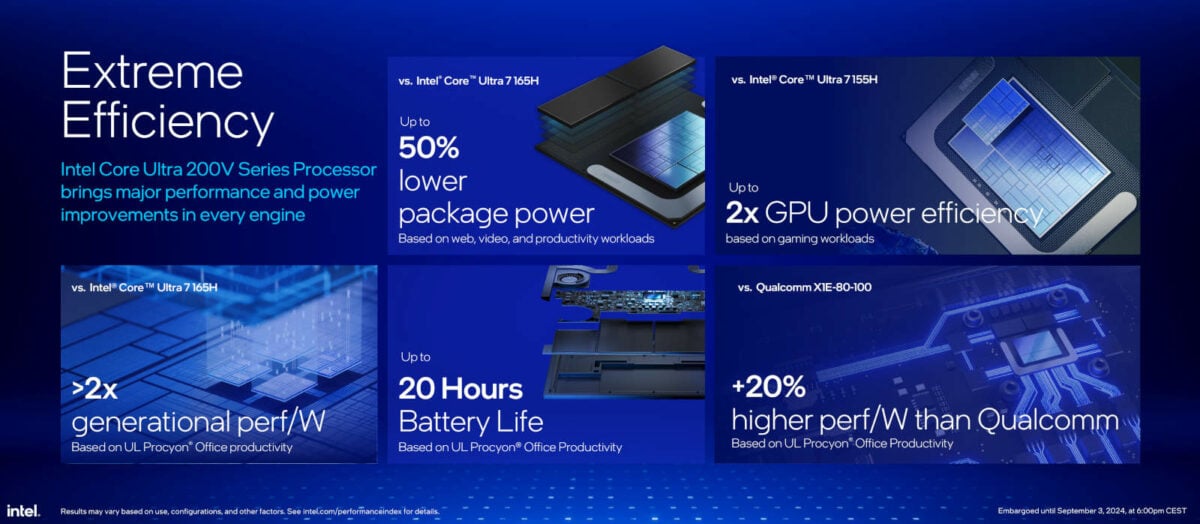
Efficiency
Intel boldly describes Lunar Lake as “the most efficient x86 processor ever.” The company’s only competitor in this space is AMD, as both Apple and Qualcomm use the ARM instruction set for their CPUs. Much as this narrows the scope of Core Ultra 200V’s victory, it’s still a large win if the claim holds up to scrutiny.
Abandoning the split core tile of Meteor Lake and adopting a unified design, housing both P cores and LP E cores, plays a large part in this. Furthermore, the additional compute power afforded by Skymont alleviates the bottlenecks encountered on Core Ultra 100 series processors. By comparison, Lunar Lake shouldn’t nearly as often default to its Lion Cove cores, increasing efficiency for everyday tasks like web browsing or those involving office applications. To put a number on it, Intel claims up to 50% lower SoC power over the two generations.
To drive this point home, Intel’s provided a set of benchmarks highlighting the performance per watt Lunar Lake offers. Of course, these results deserve a degree of scepticism, as do all from manufacturers.
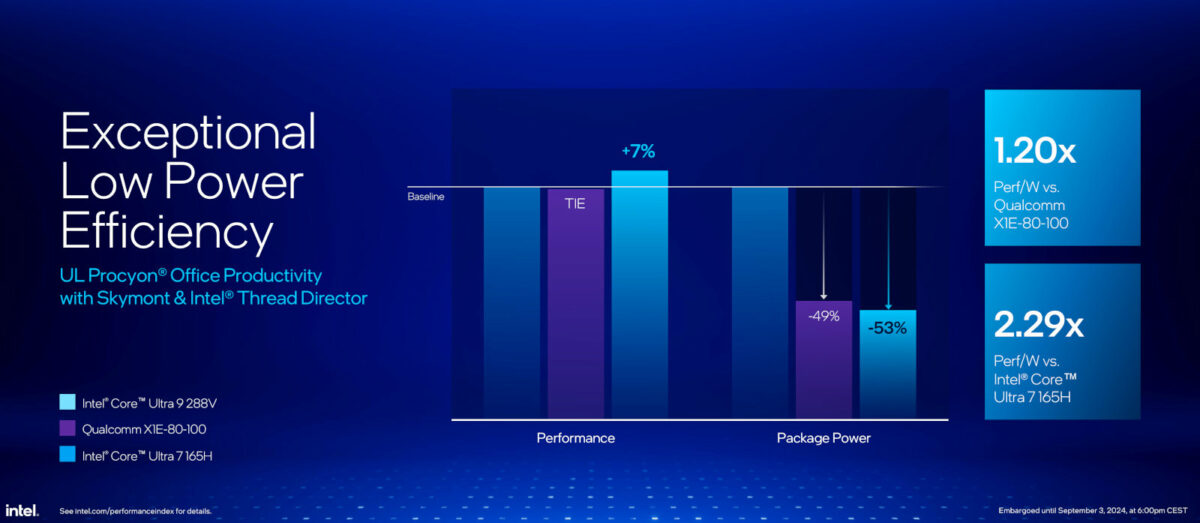
It’s in Procyon Office Productivity that we see that 50% claim materialise. Not only does is Lunar Lake’s top dog more than twice as efficient as Meteor Lake’s, but it outperforms it by 7% to boot. Comparisons to Qualcomm’s Snapdragon X Elite chip, X1E-80-100, are similarly favourable, with Core Ultra 9 288V matching the performance of its competitor using a fraction of its power.
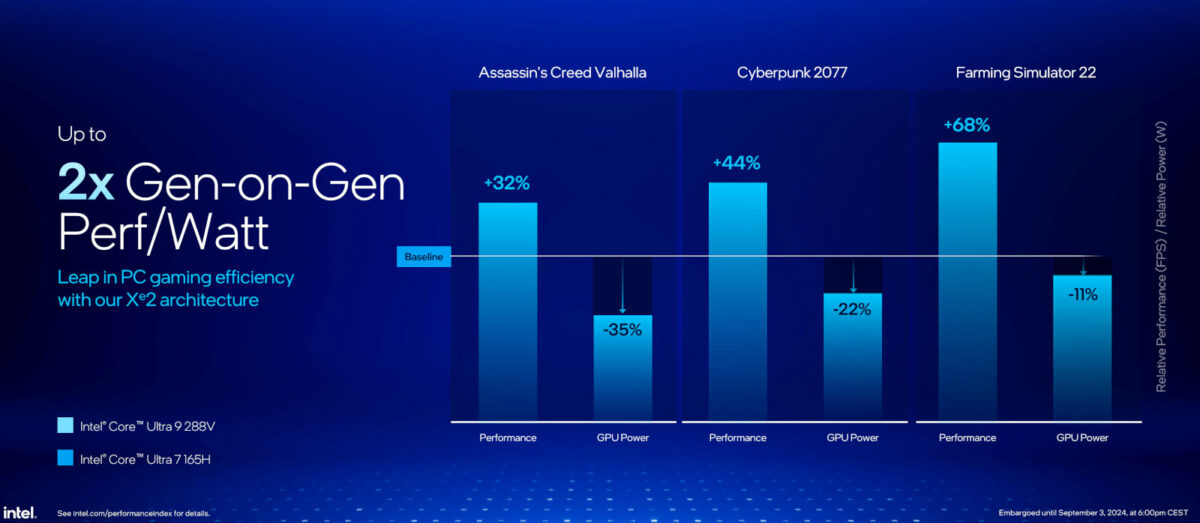
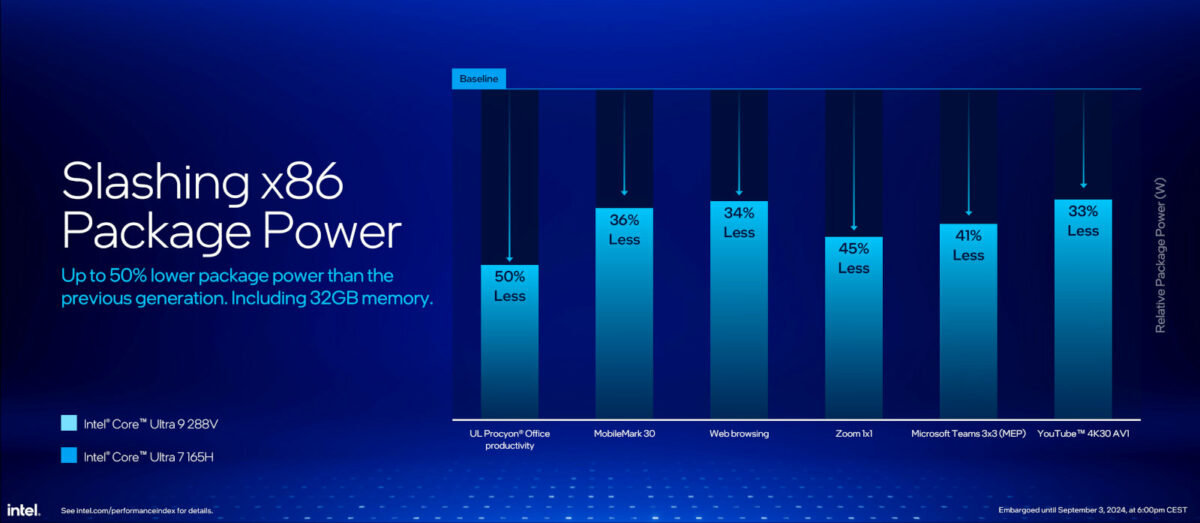
Using Core Ultra 7 165H as a baseline in gaming and general applications, we see the same story play out. Fewer watts, more performance.
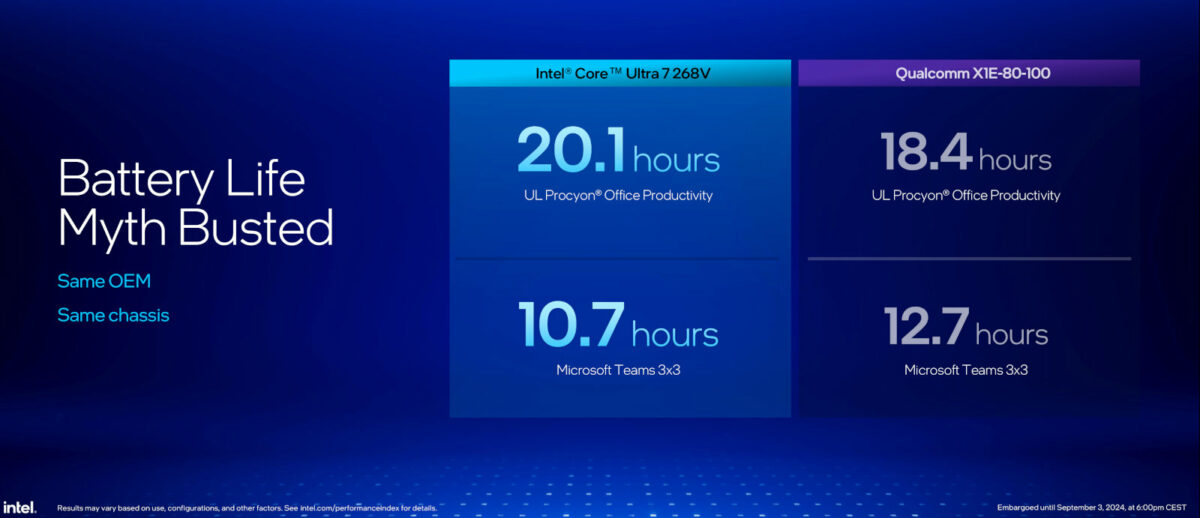
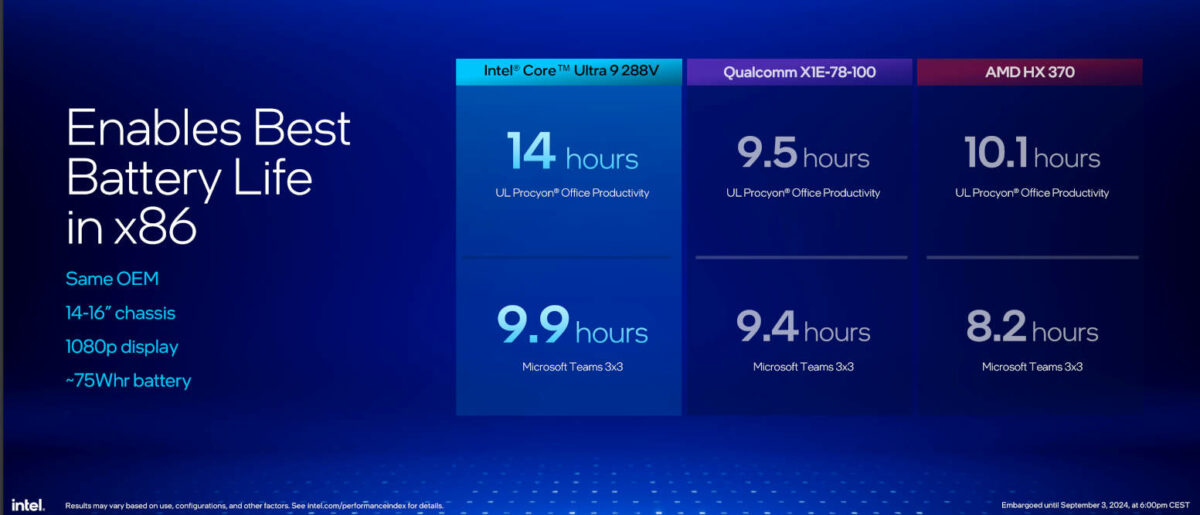
Turning to battery life, Intel takes the opportunity to make a rare comparison. Finding two laptops that are identical, save for their processor, is a rare thing, but Intel has seemingly done just that. Apples to apples, Core Ultra 7 268V to X1E-80-100, Intel comes out on top with 20.1 hours of charge to Qualcomm’s 18.4 hours. Admittedly, it does lose out in a Teams 3×3 benchmark (10.7hrs vs. 12.7hrs), so there is some give and take depending on the application.
Adopting similar chassis from the same OEM, Intel is able to compare to AMD and claims a solid lead in both benchmarks. Core Ultra 9 288V quashes both X1E-78-100 and Ryzen AI 9 HX 370, with 14 hours and 9.9 hours of battery life, respectively.
Given Core Ultra 200V’s remit of battery-powered devices, its efficiency is an important metric to its success. Intel’s improvements and claimed relative competitiveness makes for impressive reading. However, I look forward to seeing how the 9-33W TDP range of these processors affects results, if much at all. That’s not forgetting how they shift across system form factors with varying battery sizes and demands.
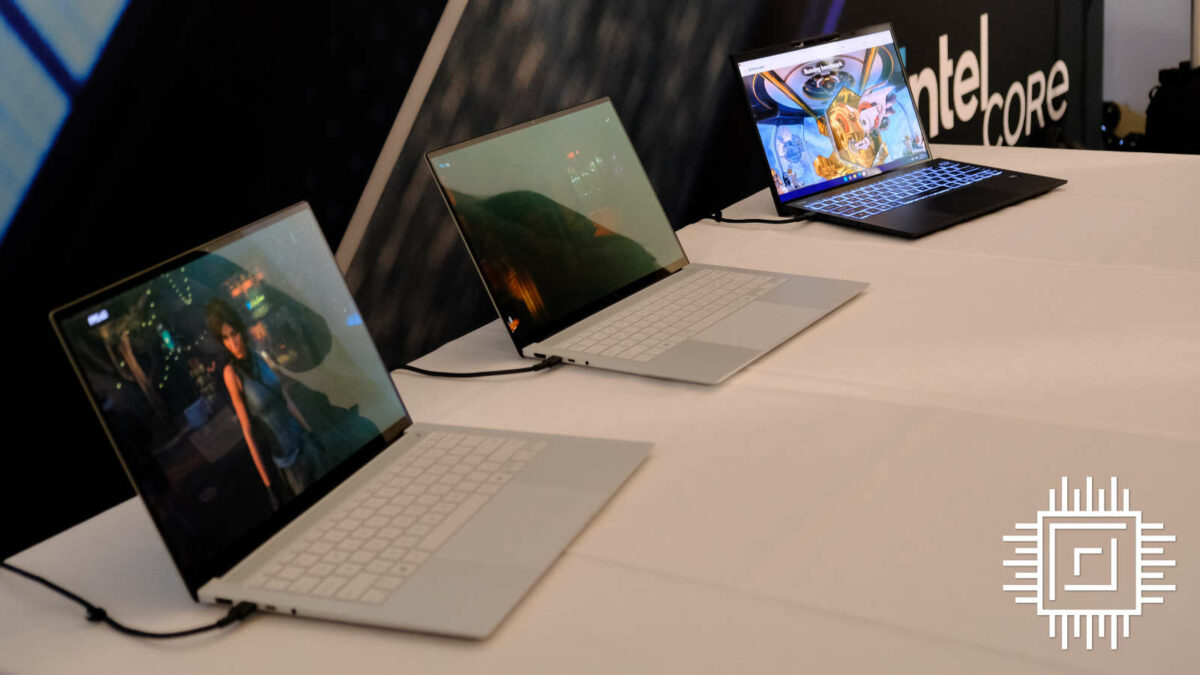
CPU performance
If Ryzen 9000 taught us anything, it’s that performance simply can’t come second to efficiency, lest you invite a largely unenthusiastic reception. Lucky for us, Intel claims its focus on efficiency hasn’t come at the cost of Lunar Lake’s compute power. Boosts to IPC, improvements to branch prediction, and the tightening of latencies all give Core Ultra 200V impressive processing power.
While Lion Cove offers up to 14% generational uplift to IPC, the biggest boost comes from Skymont which tops out at a whopping 68%. As Intel fellow Robert Hallock explains, “Skymont changes deeply improve the range of workloads that the E core complex can handle.” As mentioned, this improves efficiency by being less reliant on P cores, but also just makes for a faster chip overall.
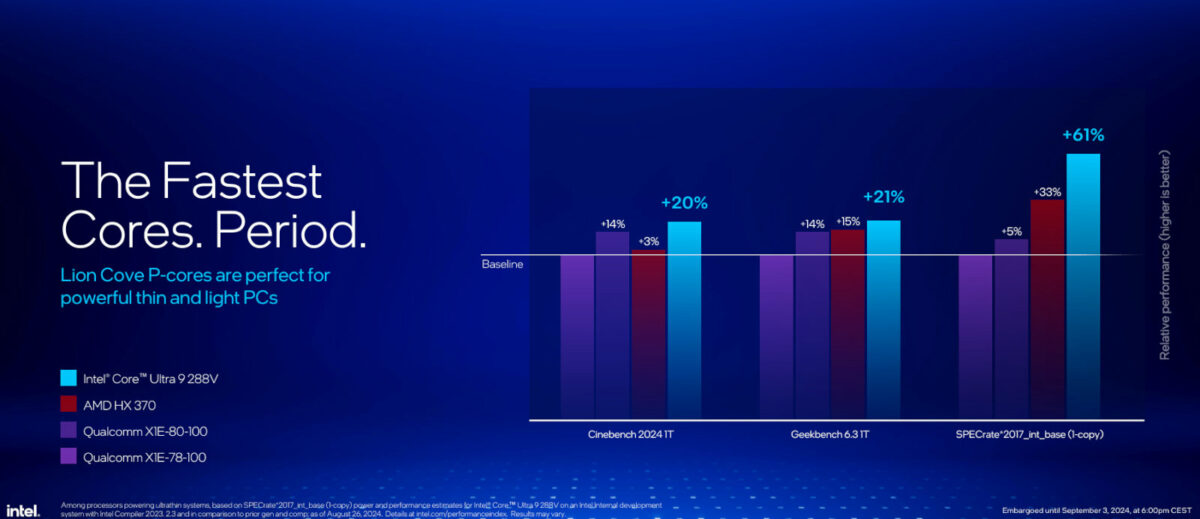
Up against Qualcomm X1E-80-100, X1E-78-100, and AMD Ryzen AI 9 HX 370, Lunar Lake’s flagship outdoes them all in a handful of single threaded benchmarks. The leads Core Ultra 9 288V enjoys vary depending on the application, ranging from 6-17% on x86 and 6-56% with ARM in the picture.
Much as these comparisons give us the relative advantage of Lunar Lake, Intel fell short of disclosing specific scores for any application. Nevermind the fact that three benchmarks do not make a processor, and we’ll be keen to see how Core Ultra 9 288V and its siblings hold up across a large suite.
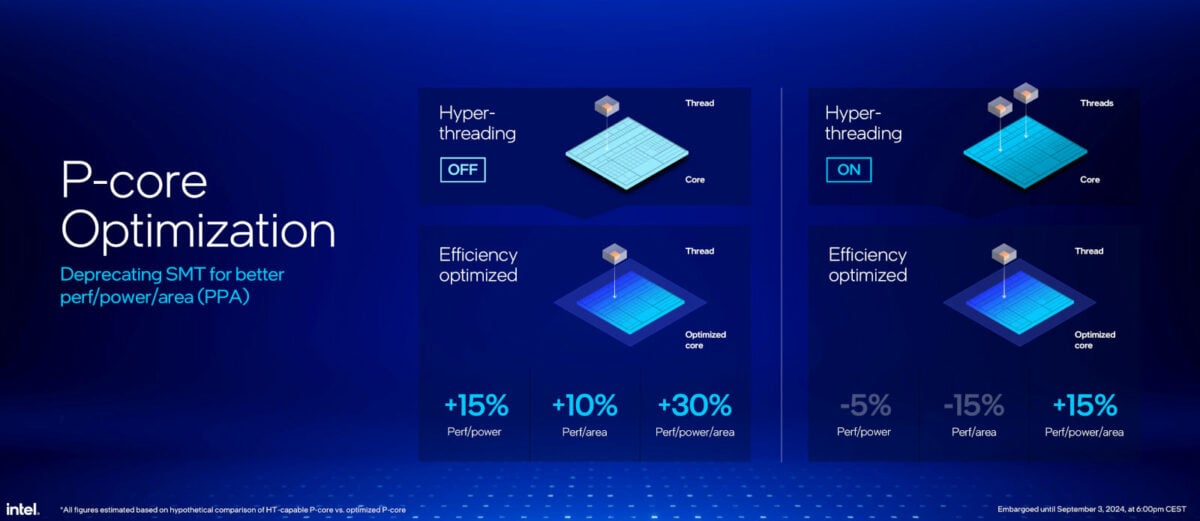
Before we discuss multi-threaded benchmarks, we need to address the elephant in the room: SMT. Intel was the first company to bring this technology to consumers with Pentium 4, all the way back in 2002. Until now, all the company’s architectures have supported the feature. So, the idea of Team Blue throwing it to the wayside is a seismic shift in design and strategy, particularly as competitors still use it.
Intel explains that SMT hampers the performance/power/area (PPA) of Lion Cove. With the feature enabled, P cores see a 15% improvement to PPA, but this doubles to 30% with it left off. As company fellow Robert Hallock explains, “we’re not always going to make the decision to remove SMT, but it makes a tonne of sense when you’re fanatical about power like we are in Lunar Lake.” Perhaps Core Ultra 300 series will see it make a return on the desktop?
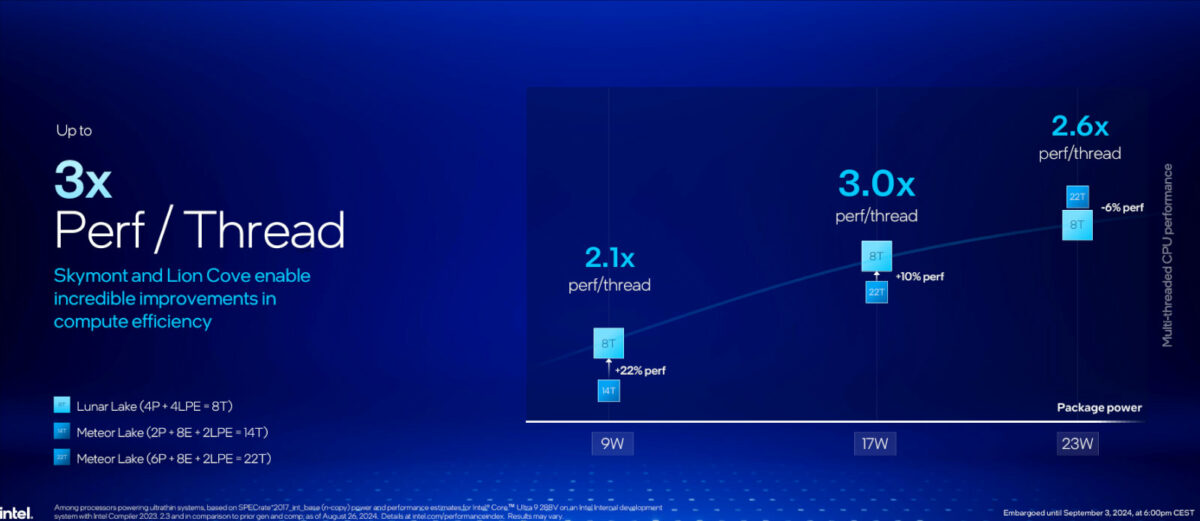
If there was any doubt that Lunar Lake does just fine without SMT, Intel claims it outdoes the performance per thread of Meteor Lake across a 9-23W range by as much as 3.0x. Comparing a 22-thread Core Ultra 100 series chip to an eight-thread Core Ultra 200 series CPU, they’re a match at 20W and the latter’s performance only falls behind by 6% at 23W.
That last point is key, as Intel hasn’t shared multi-threaded results for Cinebench 2024 or Geekbench. Despite its bravado, these omissions could be a telling sign of one of Lunar Lake’s weaknesses relative to its peers. The company does cite advantages in other applications, such as Handbrake. However, we’ll know where Core Ultra 200 series stands in this particular pecking order given time, of course.
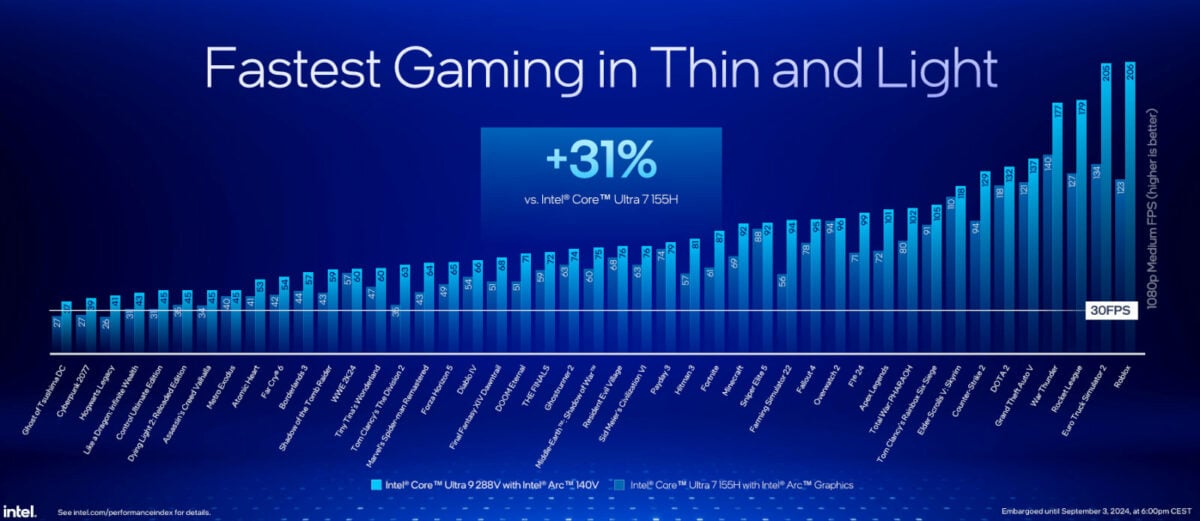
GPU performance
Intel already shared plenty about its Xe2 GPU architecture at Computex 2024, but it’s now out of the labs and pushing frames as part of Core Ultra 200V processors. While there are two chips in the Lunar Lake lineup, we only have benchmarks for the best it has to offer. Namely, Arc 140V working with Core Ultra 9 288V.
Despite the lack of Arc 130V, preliminary results for 140V from Intel are surprisingly strong. Not only is this iteration of Arc must faster than the prior generation, but it apparently goes toe-to-toe with AMD’s Radeon offerings too.
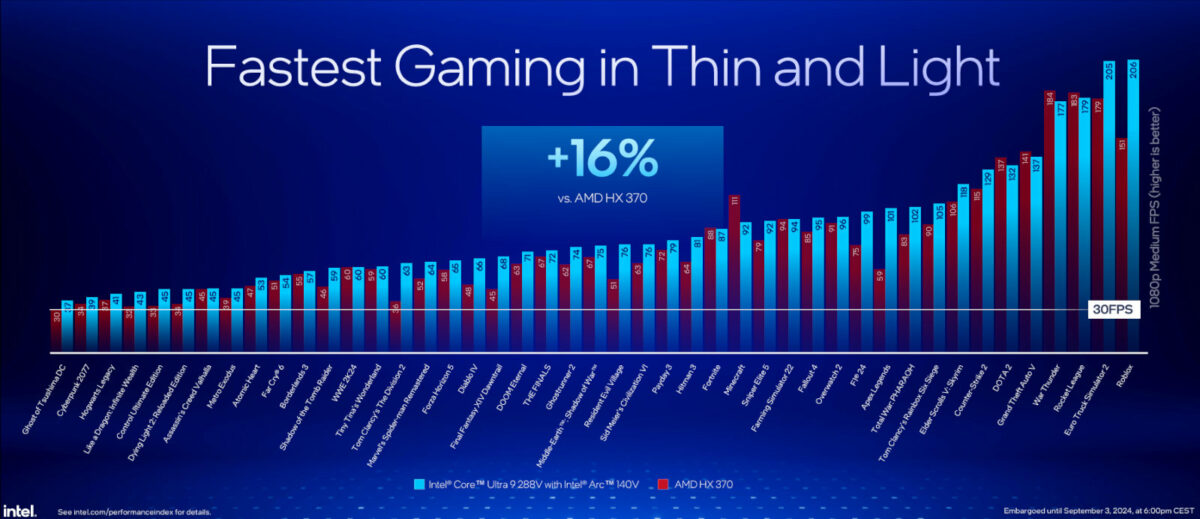
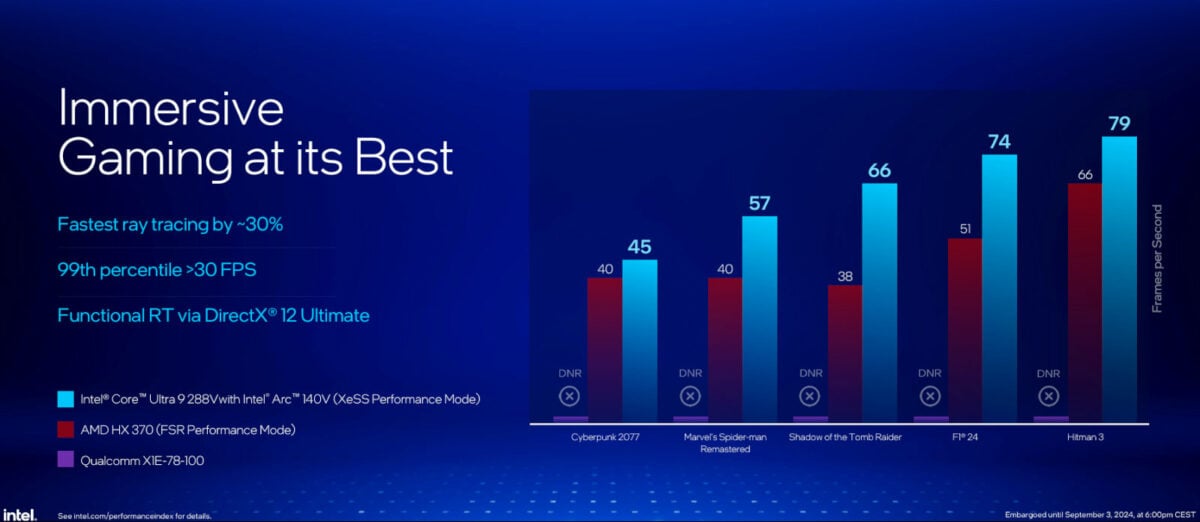
Running a suite of games at 1080p using their medium graphics presets, Intel says Arc A140V enjoys a strong 31% lead on average compared to the best graphics Meteor Lake has to offer. It also horribly embarrasses Qualcomm X1E-84-100, with a 68% lead, but it’s hard to say how much this is down to horsepower versus problems with ARM emulation.
More excitingly though, Arc A140V keeps pace with Ryzen AI 9 HX 370. Intel claims a 16% lead on average in its test suite. Xe2 boasts improved ray tracing, delivering playable frame rates with XeSS enabled. However, I’ll need to see this in action before deeming the experience itself playable. Running any upscaler in ‘Performance’ mode at 1080p sounds like the exact opposite of a feast for the eyes.

Nonetheless, I am excited to see what handhelds emerge with Lunar Lake processors. MSI’s Claw AI 8 Plus is already en route, with Acer teasing another. Gamers may finally have a real alternative to AMD chips if all goes well.
AI
Before we wrap things up, it’d be remiss of me to not give Lunar Lake’s AI capabilities a nod. Core Ultra 5 SKUs offer 40 TOPS of performance, while 7 and 9 class processors boast 47-48. Relative to the competition, it clips ahead of Qualcomm’s Snapdragon X Elite series but falls just short of the 50 TOPS available on Ryzen AI 9 HX 375’s NPU.
However, this ignores the TOPS available from the processor’s cores and graphics. Coincidentally, Hallock says Intel partners “want to use CPU, GPU, and NPU in equal proportion.” How this will manifest is unclear for now, but you can expect fast Stable Diffusion renders and broad support for data types/models from Core Ultra 200V.
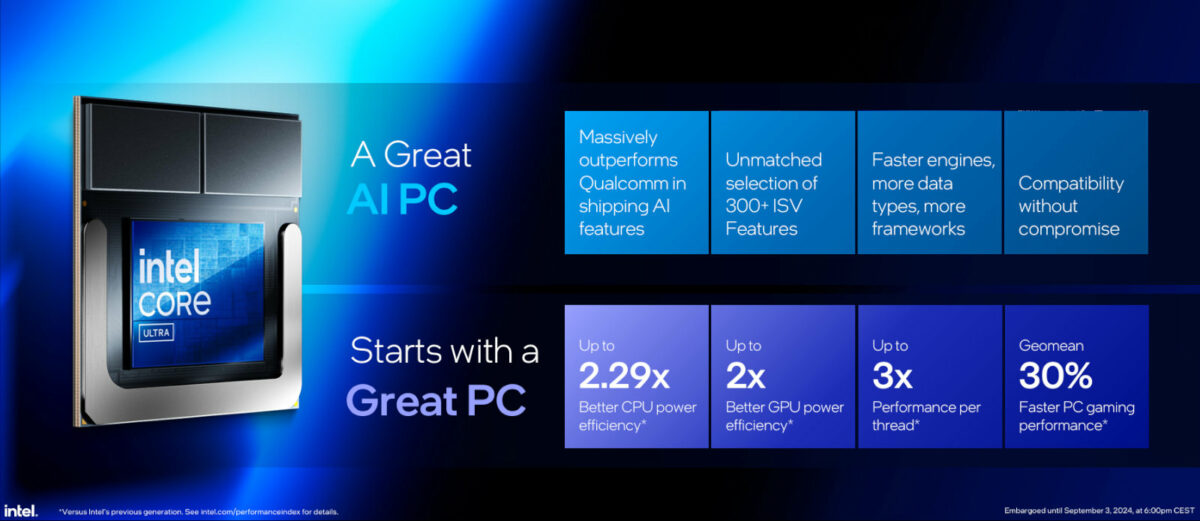
Final Thoughts
Watching Intel present Lunar Lake felt world’s away from the relatively damp squibs that were 14th Gen Core and Meteor Lake. This feels like an architecture that the company is confidently behind, as the enthusiasm behind its designers is unavoidably infectious. Even looking past the razzle dazzle, I’m still excited for Core Ultra 200V.
Lunar Lake is a glimpse of the future, with both Arrow Lake processors and Battlemage graphics sharing much of its DNA. The scalability of Intel’s Lion Cove, Skymont, and Xe2 cores remains an open question, but I’ve little reason to doubt it for now. The foundations seem solid after all.
Whether it’s via a handheld or laptop, we’ll be sure to get hands-on with Lunar Lake as soon as we can. So, stay tuned!

